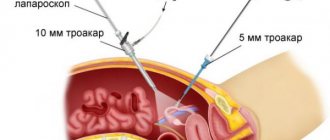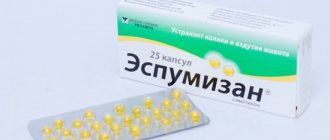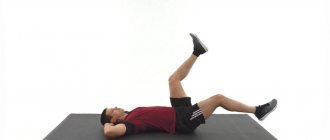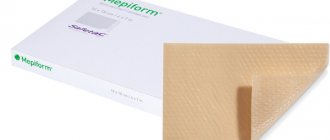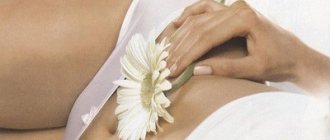Laparoscopic operations in gynecology are varied and have varying degrees of complexity. Accordingly, the recovery period varies. Patients are usually discharged 1-2 days after laparoscopic surgery. Further well-being and recovery depend on the general health of the patient and the type of surgery performed. However, the general advice after surgery is to spend a few more days at home resting.
Recommendations and restrictions
The full cycle of rehabilitation after laparoscopy takes about a month. For the first 10 days, while the stitches are healing, you need to refrain from steaming procedures, do not take a bath, or visit the pool. For 4-6 weeks, it is advisable to avoid sports, especially stress on the abdominal muscles, and do not lift or drag heavy objects. Abstinence from sexual activity is recommended for 2-3 weeks, depending on the operation, to reduce the likelihood of infections.
Professor Ter-Hovakimyan Armen Eduardovich comments:
Laparoscopy surgery is performed under general anesthesia. 3-4 punctures remain on the front wall of the abdomen. After the operation, the patient awakens in the operating room, then she is transferred to the ward. After 2-3 hours you can try to get up. The diet is as follows: you can drink no earlier than 2 hours after surgery, the first meal - after 5-6 hours. During surgery, the abdomen fills with gas, which presses on the diaphragm. Therefore, after the operation there may be pain in the shoulders and chest. These symptoms disappear in 1-2 days. To make the discomfort go away faster, you need to walk and move more. At first, the food should be light and easily digestible: cereals, soups, bananas. Avoid fatty and salty foods. Stay in the hospital - 1-2 days. After 3-4 days you can go to work. On day 7-8, the sutures are removed. Sexual rest is indicated for 2-3 weeks.
Caring for seams
Stitches after laparoscopic surgery are minimal. Therefore, they require minimal care - antiseptic treatment. After 10 days, complete healing occurs. But for the first few months, there may be a slight tightening of the tissue around the seams.
Wound care at home
- Do not remove the wound dressing for __________ hour(s) after the procedure. Keep it clean and dry.
- Remove the bandage after ______ hour(s).
- If your doctor or nurse tells you to ice the wound, you can apply an ice pack every hour while you're awake for _________ minutes. Do this for the first 24–48 hours (1–2 days) after the procedure. This will help reduce bleeding, pain and swelling.
- If Steri-Strips™ are applied to a wound, do not remove them. They will gradually fall off on their own during the first week after the procedure. The edges of the Steri-Strips will begin to peel off first. Trim the edges with scissors as you peel them off.
- There may be dried blood on the Steri-Strips; this is normal.
- If your doctor or nurse tells you to leave the strips on until your next visit, do not remove them.
- Let a weak stream of soul flow over the wound.
Cleaning the wound
Clean the wound every day. Do this for _____ days/weeks after the procedure or until your next doctor's appointment. Follow the instructions below when cleaning the wound.
Prepare everything you need
To clean the wound you will need the following:
- one package of cotton swabs (Q-tips®);
- one package of non-stick gauze pads;
- paper patch;
- adhesive tape (Band-aid®), cut to fit the wound;
- solution ______________________________;
- ointment ______________________________;
- clean gauze pad or clean dry terry cloth.
Instructions for cleaning a wound
- Prepare everything you need.
- Wash your hands with warm water and soap for at least 20 seconds or use an alcohol-based hand rub.
- Clean the wound with _____________________ solution.
- Gently pat the wound dry with a clean gauze pad or a clean, dry terry cloth. Do not rub this area.
- Using cotton swabs, apply ointment ______________________________ to the wound.
- Cover the wound with non-stick gauze cut to fit the wound or Band-aid. If you are using non-stick gauze, secure it with paper tape.
- When finished, wash your hands with warm water and soap for at least 15 seconds or use an alcohol-based hand rub.
Follow these instructions for __________ days/weeks, or until the wound has healed.
Additional instructions:
to come back to the beginning
HOW CAN YOU GET RID OF SCARS?
If an unsightly scar appears after laparoscopic intervention, comprehensive treatment must be carried out. It is unlikely that you will be able to completely get rid of the scar, but it is possible to make it less noticeable and smooth. Keloid scars that appear after surgery can be eliminated in the following ways:
- Corticosteroids are hormonal agents that help the patient's body quickly adapt to changing conditions. Steroids are injected into the puncture area and this treatment helps prevent scarring of the tissue.
- Silicone bandages, which are used to eliminate scars after laparoscopy, are considered an effective method of therapy. Such plates are applied to the wound immediately after it has healed, and they must be worn for 24 hours.
- When exposed to a laser on a wound, it is possible to smooth out the scar, make it less noticeable and not injure nearby tissues. It is recommended to resort to this method of removing scars after laparoscopy only a year after the laparoscopy.
- Freezing with cold allows you to get rid of the scar and this treatment is carried out using liquid nitrogen. In fact, cryotherapy gives a positive result only when removing fresh scars.
The main cause of atrophic scars after laparoscopic surgery is considered to be an insufficient amount of collagen fibers that are produced at the puncture site. This leads to the appearance of a scar, which extends into the peritoneum and causes the formation of a pit. You can make an atrophic scar less noticeable in the following ways:
- Biorevitalization is the introduction of fillers containing hyaluronic acid under the skin;
- Dermabrasion is a mechanical peeling, during which the scar is erased with special brushes;
- Desotherapy involves the injection of special medications under the scar.
It is important to remember that in the first time after laparoscopy, the puncture site should be protected from exposure to ultraviolet rays. The patient’s knowledge of how to handle sutures after laparoscopy allows them to be made almost invisible and neat. When a scar forms, problems can be solved using effective correction methods, which are selected by a specialist
SOURCES: https://apkhleb.ru/prochee/shvy-posle-laparoskopii https://poslevipiski.ru/gastroenterologiya/shvy-posle-laparoskopii.html https://proskopiyu.ru/laparoskopiya/shvy-posle-laparoskopii. html
Pain relief after the procedure
You may experience pain or discomfort after the procedure. To relieve these symptoms, take acetaminophen (Tylenol®) or strong acetaminophen (Extra Strength Tylenol®).
- Do not take aspirin or nonsteroidal anti-inflammatory drugs (NSAIDs) such as ibuprofen (Advil®) or naproxen (Aleve®). These medications make it harder for your blood to clot and may increase bleeding.
- Follow dosage directions on the package. If the recommended dosage does not relieve pain, call your doctor.
- If you are allergic to acetaminophen or have a medical condition that prevents you from taking it, ask your healthcare professional what medicine you can take instead.
- If you are participating in a clinical trial for cancer treatment, ask your oncologist (cancer treatment doctor) what pain medications you may take.
- You can also apply an ice pack to the wound to reduce pain, swelling, and bruising. Apply an ice pack to the wound for 15 to 20 minutes every hour or as directed by your healthcare professional.
to come back to the beginning
Rehabilitation after removal of an ovarian cyst in Moscow
Some patients underestimate rehabilitation after removal of an ovarian cyst by laparoscopy. However, a set of measures selected taking into account the individual characteristics of the patient allows not only to prevent the development of complications, but also to preserve reproductive health.
Yusupov Hospital is located in the historical center of Moscow. In this medical institution, a staff of experienced specialists helps patients improve their quality of life and maintain health. Oncologists at the Yusupov Hospital diagnose and treat both malignant and benign tumors of various locations.
The key principle of the work of specialists at the Yusupov Hospital is the use of organ-preserving techniques and minimally invasive technologies for the treatment of various pathologies. So, if a woman has an ovarian cyst after removal of the uterus, the specialist will select treatment methods aimed at preserving the ovary. Medical care provided to patients at the Yusupov Hospital meets international standards.
Women who have had an ovarian cyst torsion, rupture or other complications can go to the Yusupov Hospital for emergency help at any time of the day. Pre-registration for a consultation with specialists at the Oncology Clinic is carried out by calling the Yusupov Hospital.
Bleeding and bruising after the procedure
- You may experience swelling and bruising after the procedure. They usually go away in ____ days.
- If you experience bleeding, press a clean gauze pad firmly onto the wound for _____ minutes. A cold compress can also help reduce bleeding. If bleeding does not stop after applying pressure, call ______________ (emergency line). If the wound is above the neck, apply pressure to the area, sit up and elevate your head with pillows under it. If the wound is on an arm or leg, apply pressure to the area and lift the arm or leg above chest level.
to come back to the beginning
Signs of a normal process
The healing process of sutures may be accompanied by the following clinical picture, which often becomes a cause of concern for the patient:
- the wounds hurt with an aching character;
- moisture in the wound surface;
- abdominal bloating;
- compaction formed under the seam;
- itching
The listed signs are a normal reaction to scar healing and restoration of the skin. Thus, new flesh grows.
Daily Activities
- Do not do intense exercise such as running or lift heavy objects for __________ week(s).
- Ask your doctor or nurse when you can lift objects heavier than 5 pounds. You may be able to lift such objects immediately after the procedure, or you may have to wait until it is safe for you to do so.
- Check with your doctor or nurse before doing any exercise, such as running, jogging, or lifting weights.
- If the procedure was performed in the neck, face, back or scalp, try not to bend over at the waist before removing the sutures. Your doctor may ask you to wait __________ week(s).
- Make sure that the wound is not exposed to water (such as in a pool, bathtub, or hot tub) until the stitches are removed and the wound is completely healed.
to come back to the beginning
PROCESSING PRINCIPLE
Fresh, dry wounds need to be cared for properly. To begin with, you should make sure that the wound is dry, that there is no liquid, that there is no ichor oozing, and that there is nothing unnecessary under the seam. If this happens, then you need to contact a specialist who will tell you what to do next. In some cases, a drain is placed to provide drainage; in others, other emergency treatment of laparoscopic injuries is performed. If everything is fine, then you need to take a position convenient for processing the seams and begin the process of this processing.
- First you need to take a little sterile bandage, roll it up into a roller and, after blotting it in an alcohol solution, wipe the scar, wetting all the dimples, wounds and bumps. After this, you need to wait a little until the skin dries.
- If during the process of this treatment a person feels pain or burning, you need to roll up a gauze bandage, then moisten it in a hypertonic liquid and apply it to the seam, sealing it with a special plaster.
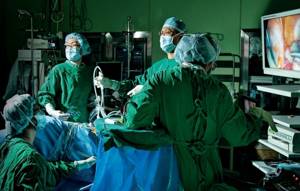
- If everything is fine, there are no unpleasant sensations, nothing hurts, then you need to take a cotton swab, dab it in green paint, then carefully treat the scar and the surrounding pits and bumps, putting a high-quality sterile bandage on it and covering everything with a plaster, which will remain there until healing.
In many cases, the doctor may allow you to leave the wound unsealed; this will, in some cases, speed up the healing process. But only in this case it is important to exercise extreme care so as not to damage the wound, not to accidentally touch it and thus not to aggravate its healing even more. Particular care is taken if the navel is sutured after laparoscopy.
Dream
- If the skin procedure was performed above the neck, sleep with the head of the bed raised 45 degrees for the first ____ days after the procedure. To do this, when going to bed, you can place 2 pillows under your head.
- If the procedure was performed on the skin of an arm or leg, sleep with this part of the body elevated above the level of the heart. To do this, you can place your arm or leg on pillows.
- Ask your nurse if you should avoid lying on or applying pressure to the wound for the first 48 hours. This may help reduce irritation and bleeding.
to come back to the beginning
Sports after laparoscopy of ovarian cyst
Recovery after laparoscopy of an endometrioid ovarian cyst requires adherence to a mode of moderate activity. Thus, in the first days after surgery, physical activity is strictly limited. After a week of recovery and bed rest, the woman can take short walks and do light exercises. Physical activity helps eliminate stagnant processes in tissues and strengthen muscle tissue.
For a woman who has undergone laparoscopy of an ovarian cyst, training and serious sports activities should be postponed for 4 months in the postoperative period. Specialists at the rehabilitation clinic, together with the patient’s attending physician, draw up an individual recovery program, one of the components of which is physical therapy.
Removing stitches
- If you have non-absorbable stitches, you will need to see your doctor to have them removed. Make an appointment with your doctor to have your stitches removed in __________ day(s)/week(s).
- If you have dissolvable sutures, they will dissolve on their own. This may take up to 1–2 months. Continue to inspect the stitches until they dissolve. They may look like small pieces of white thread in your wound. If the stitches don't bother you, let them dissolve completely. If your stitches start to bother you, call your doctor.
to come back to the beginning
When do stitches heal?
Many people are interested in when sutures are removed after laparoscopy. They are usually removed 7 days after surgery. However, there are situations when sutures are removed after 2 weeks. This most often occurs in people who are overweight.
Today, self-absorbable threads are often used. They disappear on their own a week after the abdominal threads dissolve. If everything goes without complications, the scars will become invisible after 2–3 months. During pregnancy, scars after laparoscopic surgery become brighter and form stretch marks.
When to contact a healthcare professional:
Call your healthcare provider if you experience any of the following:
- temperature 100.4°F (38°C) or higher;
- chills (getting cold and shaking);
- any of the following symptoms in or around the wound: increasing redness or swelling;
- increasing pain or discomfort;
- skin that is hard, warm, or hot to the touch;
- bright yellow or green discharge;
- bleeding that does not stop after pressure has been applied to the wound area for 30 minutes;
- unpleasant odor;
- if it seems to you that the stitch on the wound has come apart;
- rash;
- blisters;
- drainage in an amount that saturates the bandage through and through;
- any questions or unexpected problems arise.
to come back to the beginning
Recovery after laparoscopy of an ovarian cyst
Laparoscopy is a minimally invasive procedure that is used by specialists at the Yusupov Hospital in the treatment of various diseases, in particular, when removing an ovarian cyst. This operation is performed under general anesthesia, during which three punctures are made in the abdomen through which a small camera and instruments are inserted. To make the operation easier, the abdominal cavity is inflated with a special gas.
The next stage is recovery after removal of the ovarian cyst. The duration of early rehabilitation in a hospital does not exceed 7 days. Patients of the Yusupov Hospital are accommodated in comfortable rooms equipped with the necessary furniture, communications and necessary supplies.
After the ovarian cyst has been removed by laparoscopy, the postoperative period at the Yusupov Hospital takes place under the guidance of experienced oncologists, rehabilitation specialists, and surgeons. Particular attention is paid to the patient during the period of recovery from anesthesia, when she is at her weakest.
Recovery bandage
The recovery process after surgery to remove an inguinal hernia involves wearing a therapeutic bandage. This is necessary to prevent relapse. Wearing a bandage can reduce the load on the abdominal muscles and prevent muscle strain.
The bandage evenly distributes the load, reduces pressure on the problem area, and scars heal faster. The duration of wearing the bandage is determined by the doctor.
Currently, many clinics use new operating methods, when areas of potential tumor formation are fixed with the help of special implants. Thanks to this, you don’t have to wear a bandage. But many doctors recommend wearing a bandage during the rehabilitation process after removal of an inguinal hernia, at least in the initial period after surgery, when the pain is most severe.
Sex during the postoperative period
Returning to the usual rhythm of life does not happen immediately, this also applies to the intimate sphere. Sex in the first week after removal of an inguinal hernia can provoke a number of undesirable consequences: the appearance of severe pain, swelling, and the formation of hematomas. There is a risk of infection and suture dehiscence. But, if the postoperative rehabilitation of the removed inguinal hernia goes well, then it will be possible to return to intimate relationships two weeks after surgery.
This can only be done if there is no swelling, pain, or discomfort. And even in this case, you need to try to avoid excessive stress and stress.
If you follow the doctor's recommendations, most patients have a postoperative period without complications.

